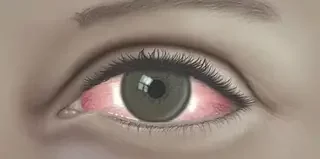
It is the season of "red eyes". There seems to be free distribution" of conjunctivitis (pink eye) which is commonly known as "Apolo" in Abuja and its environs in the past few weeks, with many people appearing in red eyes which is the common way of identifying the infection.
Medical books noted that conjunctivitis (pink eye), is an irritation or inflammation of the conjunctiva which covers the white part of the eyeball. It's also an inflammation or infection of the outer membrane of the eyeball and the inner eyelid which often result in swollen and red eye. The infections come in season, and never disappear until it completes its circle, according to optometrists.
More than 1.5 million cases of conjunctivitis (Apolo) are recorded in Nigeria every year, even though the cases are often resolved within days to weeks through self medication or doctor's prescriptions.
The infection is not new, but many people who came down with the infection this period, believed they ought to have outgrown it because of the strong body immunity they might have built over the years. Unfortunately, that was not the case.
Lately, many people that rarely use dark eye glasses (sun shade) surprisingly began to appear in thick dark eye glasses (sun shade) because they might have contracted the infection, and as a result, their eyes have turned red, thus making it difficult for them to use the eyes effectively.
Some said that in addition to difficulty in seeing, the case come with serious headache, fever, tiredness and inability to move and operate freely in the sun without covering their eyes with thick dark eye glasses.
However, the infection has spread faster than expected recently. Friends now avoid each other, same with family members especially the ones that suddenly appeared with thick dark eye glasses (sun shade) because of the suspicion that they might had contracted the infection, and are ready to distribute them considering the fact the infection is highly contagious.
Causes of conjunctivitis
Research indicated that conjunctivitis commonly known as "Apolo" is majorly caused by allergies, a bacterial or viral infection, and it's extremely contagious and can spread by contact with eye secretions from an infected person(s).
When the infection is contracted, the conjunctiva become inflamed as a result of the bacterial or viral infection, which is known as infective conjunctivitis. The eyes turns red and painful because of the inflammation thus making it difficult for the infected person to use the eyes.
How it spreads
Optometrists (eye doctors) in Nigeria have repeatedly called for serious caution in handling the cases of conjunctivitis commonly known as 'Apolo" because they are highly contagious as confirmed by the eye doctors who further warned that the conjunctivitis (Apolo), being a viral infection never stop being active until it completes its round of activities among the people in an exposed environment.
Being a very contagious disease, the Optometrists said the conjunctivitis can spread easily from person to person but it spreads faster via touching, hand shake from infected person to another person, even as the viruses and bacteria freely move from someone's hand to another.
The virus and bacteria also spreads when someone, knowingly or otherwise, touch surfaces contaminated with bacteria or viruses, then touch the eyes before washing and sanitizing the hands; as well as using or sharing makeup that's contaminated with bacteria or viruses.
Many people may also not believe the fact that conjunctivitis (Apolo) is also a Sexually Transmitted Infection (STIs) which spreads when someone touches semen or vaginal fluid of an infected person and then touch the eyes without first washing the hands.
Nevertheless, the spread of the disease can be significantly reduced by following some simple steps to keep good hygiene practices especially regular hand washing.
To limit the spread, medical experts suggested that infected person(s) should practice regular hand wash with soap and warm water, and that should be done before and after cleaning or applying eye drops or ointment to the infected eye, in addition to several other hygiene practices.
How to know it's conjunctivitis
Optometrists said in addition to several other signs that could present in a suspected case, conjunctivitis commonly known as "Apolo" comes with redness in the white of the eye or inner eyelid, increased tearing, thick yellow discharge that could crusts over eyelashes especially after sleep, green or white discharge from the eye.
Eye doctors also said that signs like gritty feeling in one or both eyes, itchy eyes (especially in pink eye caused by allergies), burning eyes (especially in pink eye caused by chemicals and irritants), blurred vision, increased sensitivity to light, swollen eyelids, among others, are all indications that someone has contracted the infection.
However, the eye doctors insisted that a suspected case must be presented to a doctor for further diagnosis and possible prescription of necessary drugs. "It's only healthcare provider that can diagnose and made the right medical prescription, perhaps, after the diagnosis."
Treatment
First, diagnosis is expected to be conducted on a suspected case(s). Based on the outcome of the diagnosis, prescription could be provided to guide the treatment of the patients.
However, some kind of eye drops, ointments are often recommended by the doctors for an infection that was caused by a bacteria. While the eye doctors confirmed that the infection caused by a virus doesn't need treatment unless it's caused by herpes simplex virus, varicella-zoster virus (chickenpox/shingles) or a STI. These are serious infections that require antiviral medications. If not treated could scar the eye or cause vision loss.
Infection caused by allergies is often treated with prescription or over-the-counter eye drops that contain either antihistamines to control allergic reactions or anti-inflammatory drugs such as steroids or decongestants.
Doctors, however, insisted that infections caused by STIs are uncommon, but can be serious. However, approach used to treat bacteria and viral conjunctivitis can be applied to treat cases caused by STIs.

















Comments